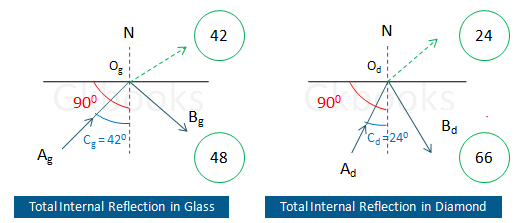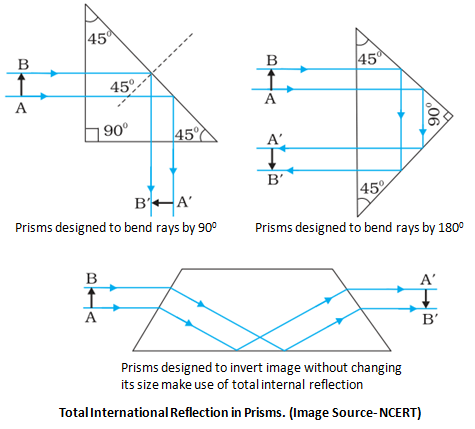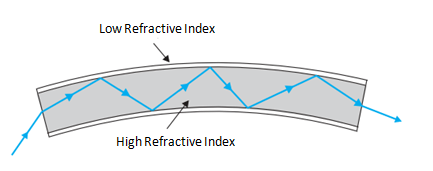Dear Aspirants,
General Science is a key subject in all competitive exams, including SSC CGL, RRB NTPC, CDS, and UPSC. One critical area within physics that often features prominently in these exams is “Ray Optics.” Specifically, “Total Internal Reflection” is a topic that frequently appears, with 2-3 questions typically devoted to it.
In this comprehensive guide, we will explore the details of “Total Internal Reflection,” explore the phenomenon of “mirage formation in hot deserts,” and examine various applications of Total Internal Reflection. These notes are designed to provide you with a thorough understanding of the concepts and help you excel in your exams.
What is Total Internal Reflection?
Total internal reflection is a phenomenon that occurs when light traveling from a denser medium (like glass or water) to a less dense medium (like air) strikes the boundary between the two mediums at a specific angle. At this critical angle, all the light is reflected into the denser medium, and no light is refracted (bent) into the second medium.
Understanding The Total internal reflection
Total internal reflection (TIR) is a fascinating phenomenon that occurs when light travels from a denser medium (like water or glass) to a less dense medium (like air).
As the light ray enters the rarer medium, it usually bends away from the surface (refraction).
However, there’s a special angle called the critical angle. At this critical angle, something amazing happens: the light ray doesn’t refract at all.
Instead, it grazes the boundary between the two mediums – almost like skipping a stone on water – before being completely reflected into the denser medium.
Unlike reflections from mirrors, this complete reflection happens without any physical barrier! It’s the reason why fiber optic cables can transmit light over long distances with minimal signal loss. The light rays bounce around inside the cable due to TIR, effectively guiding the light signal to its destination.
✅ Also Read: Image formed by Plane Mirror
Diagram of Total Internal Reflection
Consider the following ray diagram of total Internal Reflection _
Here,
AO1 is the incident ray
O1B’ is a partially reflected ray, and
O1B is a partially transmitted ray
Now, let’s see what happens if we gradually increase the value of the angle of incidence.
When we gradually increase the angle of incidence, then at a certain angle (ic= ∠AO3N), the refracted ray (∠O3D) is bent so much away from the normal that it passes through the surface at the interface between the two media. This phenomenon is called the Grazing effect as the bending refracted ray grazes the interface between the two media.
In the grazing effect phenomenon, the angle of refraction is 90 deg. The angle of incidence ∠AO3N is called the critical angle (ic) for the given pair of media.
If the incidence angle is increased further (e.g., the ray AO4), refraction is stopped, and the incident ray is reflected. This is called total internal reflection.
Critical angle of some transparent media for air
| Substance medium | Critical angle | Refractive index |
|---|---|---|
| Diamond | 24.41 | 2.42 |
| Dense flint glass | 37.31 | 1.62 |
| Crown glass | 41.14 | 1.52 |
| Water | 48.75 | 1.33 |
Conditions for Total internal reflection in a nutshell
There are two conditions for the total internal reflection to take place. They are:
- Light Needs to Go From “Denser” to “Rarer”: For total internal reflection (TIR) to happen, the light ray must travel from a denser medium (like glass or water) to a rarer medium (like air).
- Hitting the Critical Angle: There’s a specific angle, called the critical angle, at which total internal reflection occurs.
Total internal reflection in nature
Mirages: A Cool Trick of Light (TIR in Action!)
Mirages are amazing optical illusions caused by total internal reflection (TIR). Imagine a hot desert day. The scorching sun heats the sand, creating a layer of hot air near the ground.
This hot air is actually less dense (thinner) than the cooler air above it. When light rays from the sky travel from the cooler air (denser) towards the hot sand (rarer), they can bend due to TIR.
If the angle is right (the critical angle), the light gets completely reflected towards the observer. This reflected light makes it appear as if there’s water on the ground, like a shimmering lake – a mirage!
Mirage: A Shimmering Illusion Explained
A mirage is a fascinating optical illusion caused by bending light rays in the atmosphere. Crucially, it involves total internal reflection (TIR) in some cases.
Here’s the science behind it:
When hot desert sand or pavement heats the air close to the ground, it becomes less dense (thinner) compared to the cooler air above. Light rays traveling from the sky encounter this air layer with varying densities. Due to refraction and, in some cases, TIR, these light rays bend and can be reflected towards the observer. This reflection creates the illusion of a shimmering pool of water on the hot ground.
In where Mirage has generally been Found
• Mirage is especially common in hot deserts.
• It is also found on a road on a hot summer day.
For example, you might have noticed that while moving in a car during a hot summer day, a distant patch of road appears to be wet, especially on a highway. However, upon arrival at the scene, we do not find any evidence of water.
How Mirage occurs in a hot desert
• On hot summer days, the layer of air near the ground (sand) becomes hotter than the layer of air at higher levels.
• Cold air is much thicker than hot air. As the air temperature gradually decreases from low to high levels, it forms a few layers of denser and rarer medium and the optical density at different layers of air increases with height.
• Now, when light from a tall object such as a tree, passes through the denser (upper level) to rarer (lower level or just below the upper level) medium the ray of light successively bends away from the normal and undergoes total internal reflection if the angle of incidence of the air near the ground exceeds the critical angle.
Total Internal Reflection in Diamond
Why Diamonds Sparkle: The Science of Total Internal Reflection
Have you ever wondered why diamonds sparkle so much brighter than glass, even when cut similarly? The secret lies in a fascinating phenomenon called total internal reflection (TIR).
Light bends as it travels from one medium (like a diamond) to another (like air). Something amazing happens when light hits the diamond-air interface at a specific angle (called the critical angle). Instead of refracting (bending) out, the light ray completely bounces back inside the diamond – a total internal reflection!
Diamonds have a much smaller critical angle (around 24.4°) compared to glass (around 42°).
This means that light entering a diamond is far more likely to undergo TIR and stay trapped inside. As light bounces around within the diamond, it interacts with the facets (cut surfaces) and reflects outwards at various angles, creating the dazzling sparkle we see.
By contrast, light refracts out more easily in glass due to the larger critical angle. This allows less light to be reflected internally, resulting in a less brilliant sparkle.
TIR acts like a tiny prison for light inside a diamond, maximizing the light that interacts with the facets and creating that spectacular sparkle we all love.
Total Internal Reflection in Prism
• Prisms designed to bend light by 90° or by 180° make use of total internal reflection. Such a prism is also used to invert images without changing their size.
• In the first two cases, the critical angle for the material of the prism must be less than 45°. We see from Table 9.1 that this is true for both crown and dense flint glass.
Application of Total Internal Reflection
• In modern times, total internal reflection has many important applications such as_
Optical fibers
♦ Data Transmission:
• Optical fibers are extensively used for transmitting and receiving electrical signals which are converted to light by suitable transducers.
◘ Visual examination of internal organs:
• Optical fibers can also be used as a ‘light pipe’ to facilitate visual examination of internal organs like the esophagus, stomach, and intestines.
◘ Decorative lamp:
• A bundle of fine plastic fibers with their free ends fixed over an electric lamp and the other end forming a fountain-like structure.
• When the lamp is switched on, the light travels from the bottom of each fiber and appears at the tip of its free end as a dot of light.
Diagnostic tools like endoscopy
• To see the inside of the human body, such as the stomach and the duodenum.
Sparkling Brilliance of Diamonds
• Total Internal Reflection phenomena used in polishing of diamonds, to create a sparkling Brilliance effect in a diamond.
In optical instruments like Periscope, Binoculars
• Total Internal Reflection phenomena used in Periscope and Binoculars to bend light at 900 and 1800.
Cat’s eye reflectors
• Cat’s eye reflectors reflect the light rays from a car’s headlamps back to the driver. This makes the road visible at night.
Single-lens Reflex Camera (SLR)
• In a Single-lens Reflex Camera a pentaprism is used to reflect the light several times to correct the inversions caused by the lens and align the image with the viewfinder.






